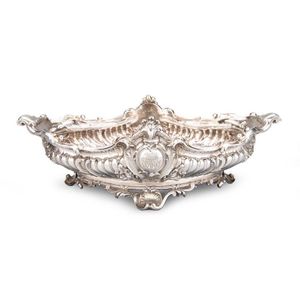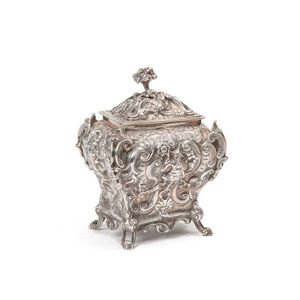George IV Silver Chinoiserie Tea Caddy by John Wintle
You must be a subscriber, and be logged in to view price and dealer details.
Subscribe Now to view actual auction price for this item
When you subscribe, you have the option of setting the currency in which to display prices to $Au, $US, $NZ or Stg.
- George Iv - George IV (1762 ? 1830) was king of the United Kingdom of Great Britain and Ireland and king of Hanover from 1820, until his own death in 1830. From 1811 until his accession in 1820, he served as Prince Regent during his father's final mental illness.
In English furniture design, his reign from 1811 to 1830 is known as the Regency period. - Circa - A Latin term meaning 'about', often used in the antique trade to give an approximate date for the piece, usually considered to be five years on either side of the circa year. Thus, circa 1900 means the piece was made about 1900, probably between 1895 and 1905. The expression is sometimes abbreviated to c.1900.
- Chinoiserie - Furniture and decorative items decorated in imitation of a Western interpretation of the Chinese style. The Chinoiserie style first became popular in the late 17th century, though there were frequent revivals, notably by Chippendale (hence 'Chinese Chippendale') during the Regency period, and the Anglo-Japanese style in the second half of the 19th century.
The ubiquitous 'willow pattern' is the most common 'Chinese' theme used in porcelain, while on furniture the Chinoiserie style usually has black or red painted and lacquered decoration, though the hallmark of the furniture style is the use of fretwork in geometrical patterns, pagodas and other decorative forms.
Japonaiseries, as the name implies, are motifs in imitation of the Japanese taste.
See also "Chinese Chippendale". - Sterling Silver - Sterling silver is a mixture of 92.5% pure silver and 7.5% of another metal, usually copper. Fine silver is 99.9% pure silver, and is relatively soft and the addition of the very small amount of copper gives the metal enough strength and hardness to be worked into jewellery, decorative and household objects.
This item has been included into following indexes:
Visually similar items

A William IV sterling silver shaped circular entree dish and fluted domed cover by Paul Storr, London 1835 on original Antique Sheffield plate two handled warming stand by Roberts, Smith & Co, the dish with bold rocaille shell, leaf and gadrooned rim, loop

A substantial Japanese Satsuma vase and cover, Meiji period, C.1890, the main design of Buddhist arhats with side adornments of porcelain modelled ties in gilt gold and the base decorated with roundels, the lid decorated with a Shishi (Fo-dog) finial, this

A massive French silver oval centrepiece by Odiot, Paris, circa 1900 with rocaille shell and scroll base, fluted body with applied oak leaf and acorn sprays, feather and scroll border and cartouches engraved with cyphers, 19 cm high, 58 cm wide, 34 cm deep

Lidded tureen of unknown material and origin, possibly Yixing stoneware, modelled with gilded rope twists, chrysanthemum flower petals, elephant head handles and raised on four feet, the inside of the lid and base has been lacquered in black. Small chips a
